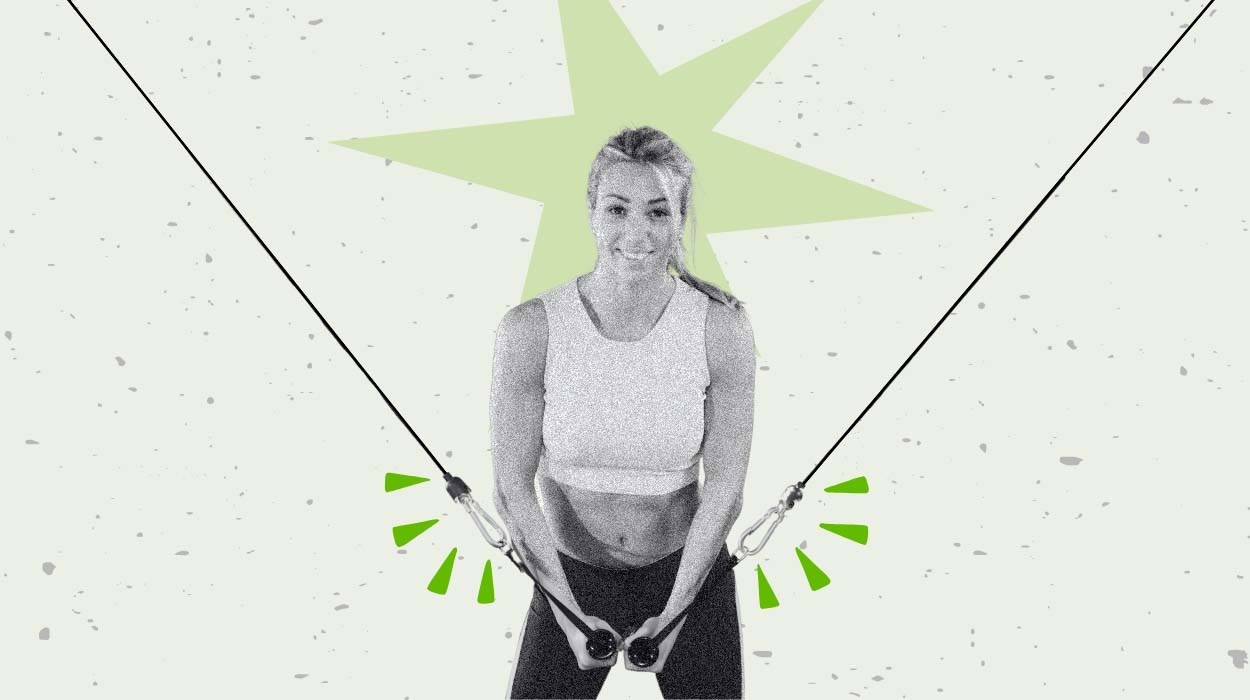
If you want to level up your fitness regime with an effective, versatile, and challenging workout, look no further than cable ab workouts. However, core exercises using a pulley machine are fantastic additions to any fitness regime. They introduce a new dynamic that can result in tremendous gains in both strength[1] and physique.
No belly exercise in the world will zone in on fat reduction in the abdominal muscles. However, these cable ab exercises and a proper diet (or help from fat burners) will help you achieve your goals here.
Cable Core Exercises For A Strong Core
Cable Ab Workouts For You To Try
For a cable ab workout with weights, choose the appropriate weight bar on the cable machines for your strength and endurance before starting your cable ab exercise routine.
Standing Cable Crunch
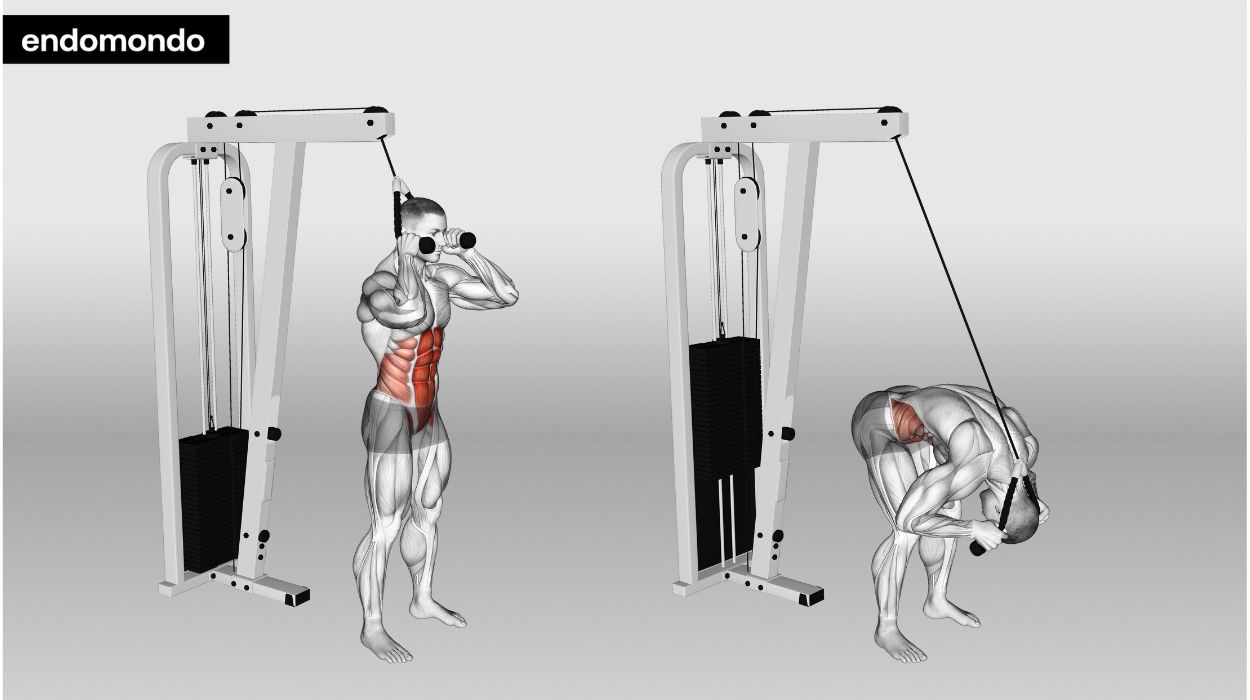
The Standing Cable Crunch targets the core muscles, particularly the abdominals. Performed using a cable machine, the individual stands, facing away from the machine, holding the cable rope with both hands near the head. The exercise involves crunching downward, flexing the abs, then slowly returning to standing.
How to do:
- Stand in front of a cable machine with your feet shoulder-width apart.
- Grab the rope attachment from a high pulley and hold it at the sides of your face.
- Bend your hips and knees slightly.
- Keep your hips stationary, exhale, and flex your waist to bring your elbows towards your knees.
- Hold the contracted position briefly with your core muscles engaged, then slowly return to the starting position as you inhale.
- Keep your movements controlled, focusing on the contraction of the abs.
Tips:
- Focus on abdominal contraction: Emphasize contracting your abs throughout the movement, not just pulling with your arms or bending your back.
- Control your movement: Perform both the crunching and returning phases slowly and with control to maximize muscle engagement and reduce the risk of injury.
- Keep your hips and legs stable: Avoid moving your hips or legs; the motion should come solely from your upper body.
Optimal Sets and Reps: Aim for 3-4 sets of 10-12 repetitions each.
Cable Wood Chop
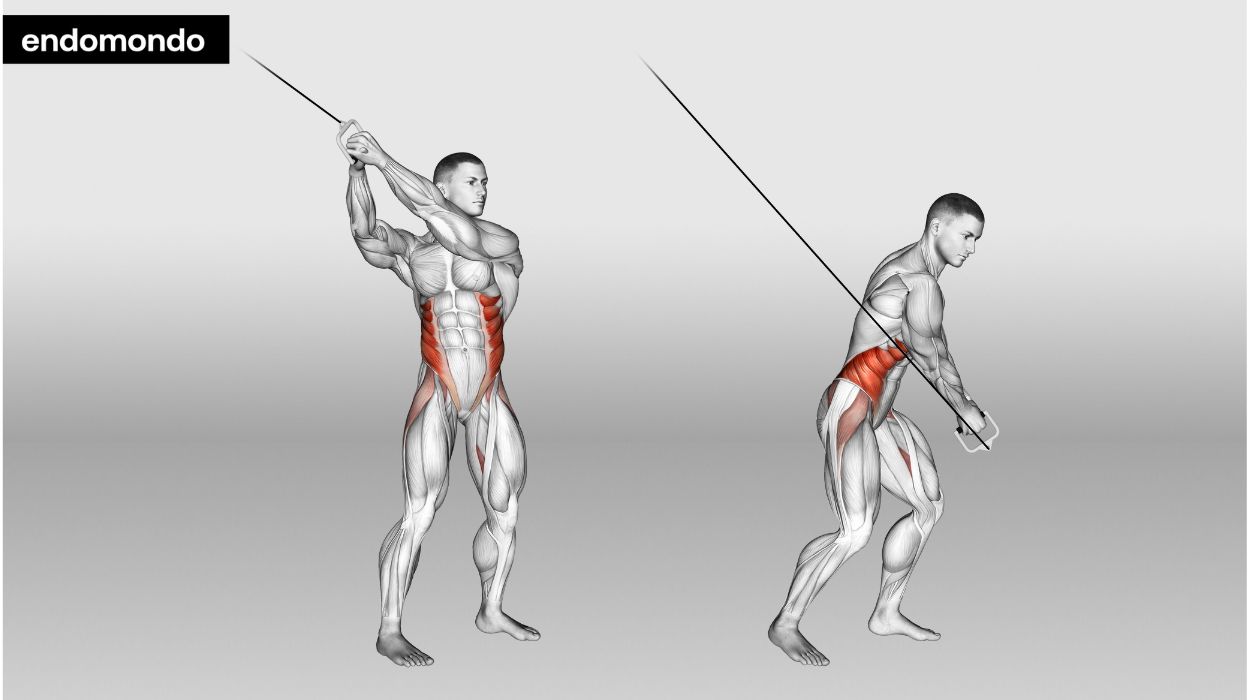
The Cable Wood Chop is a dynamic exercise targeting the core, particularly the obliques, and also engaging the shoulders and legs. Performed using a cable machine, it involves standing sideways to the machine and gripping the handle with both hands. The movement starts from either high or low on the machine, and the individual rotates their torso, pulling the cable across the body in a chopping motion.
How to do:
- Position yourself next to a cable machine with your feet shoulder-width apart.
- Grab the handle of a high pulley with both hands and arms fully extended.
- With your arms extended, pull the handle diagonally across your body towards your opposite hip while keeping your arms straight.
- Bend your knees and rotate your torso as you pull.
- Return to the start position in a slow and controlled manner.
- Repeat for the desired number of reps and switch sides.
Tips:
- Rotate with your core: Ensure the movement is driven by your core muscles, not just your arms, to effectively target the obliques.
- Maintain a stable lower body: Keep your legs and hips steady, allowing the rotation to come from your torso for a full range of motion.
- Control the cable: Move the cable in a controlled manner, resisting the pull of the cable on the way back to engage your muscles thoroughly.
Optimal Sets and Reps: Perform 3 sets of 8-12 repetitions on each side.
Cable Reverse Crunch
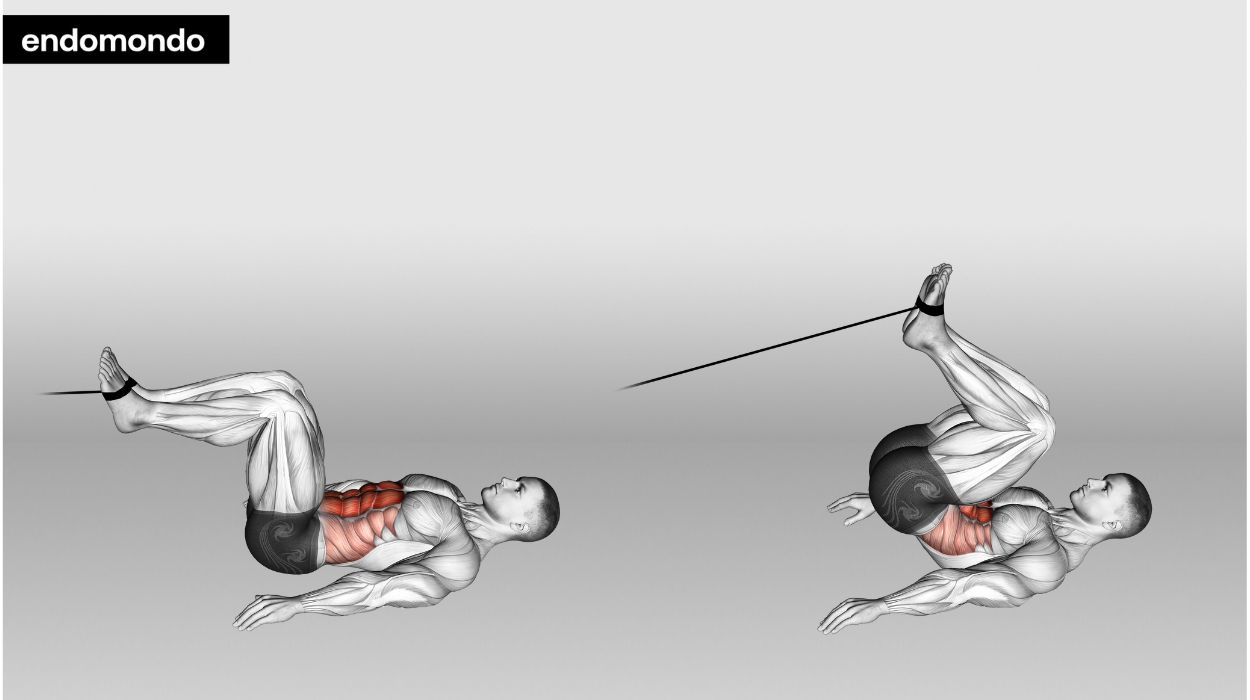
The Cable Reverse Crunch is an effective core exercise, primarily targeting the lower abdominals. Performed on a cable machine, it involves attaching ankle straps and lying on your back. This exercise strengthens the core, improves stability, and enhances lower abdominal muscle definition, all while maintaining a controlled motion.
How to do:
- Lie on your back on the floor and place your feet towards a low pulley cable with an ankle strap on both ankles.
- Keep your hands by your side or underneath your glutes for support.
- With your knees slightly bent, raise your legs until your thighs are perpendicular to the floor.
- Contract your abs and curl your hips off the floor towards your chest.
- Pause, then slowly lower back to the start position in a controlled manner.
Tips:
- Focus on abdominal engagement: Concentrate on using your lower abdominals to lift your legs, rather than relying on momentum.
- Control your movement: Perform both the lifting and lowering phases slowly and with control to maximize muscle engagement and reduce the risk of swinging.
- Keep your movements compact: Avoid extending your legs too far away from your body, which can strain your lower back.
Optimal Sets and Reps: Aim for 3-4 sets of 10-12 repetitions each.
Kneeling Cable Crunch
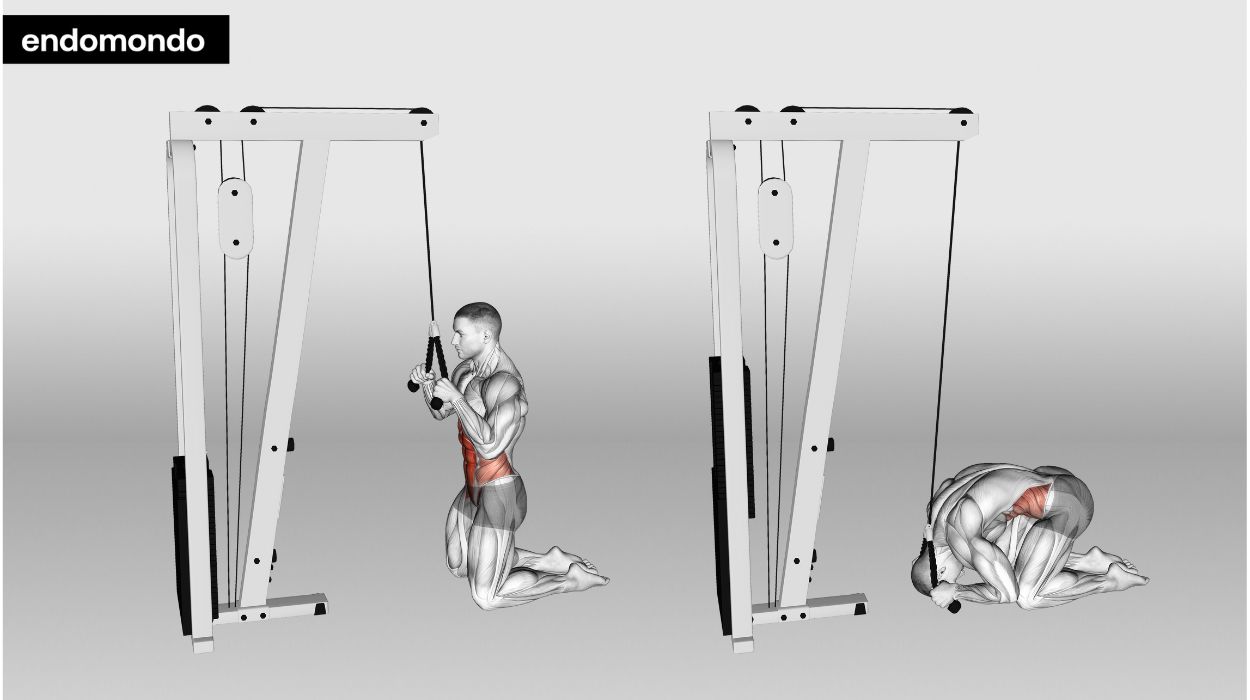
The Kneeling Cable Crunch is a core-strengthening exercise focusing on the abdominals. Performed by kneeling before a cable machine, the individual grips the rope attachment overhead. The exercise involves crunching the torso downward against the cable resistance, engaging the abs intensely, and then slowly returning to the kneeling position.
How to do:
- To do cable crunches, kneel in front of a cable machine and grab a rope attachment from a high pulley.
- Grasp the cable rope attachment and pull down until your hands are placed next to your face.
- Flex your hips slightly and allow the weight to hyperextend the lower back.
- Keep your hips stationary, flex your waist, and contract your abs to curl the upper torso downward.
- Hold for a moment at the bottom of the contraction and then slowly return to the starting position.
Tips:
- Keep your hips stable: Avoid pushing your hips back as you crunch down, ensuring the movement is isolated to your abdominal muscles.
- Focus on form over weight: Choose a cable weight that allows you to perform the exercise with proper form, rather than opting for too heavy a weight.
- Exhale on contraction: Exhale as you crunch down, deepen the abdominal contraction, and inhale as you return to the starting position.
Optimal Sets and Reps: Aim for three to four sets of 12 to 15 repetitions each.
Cable Russian Twist
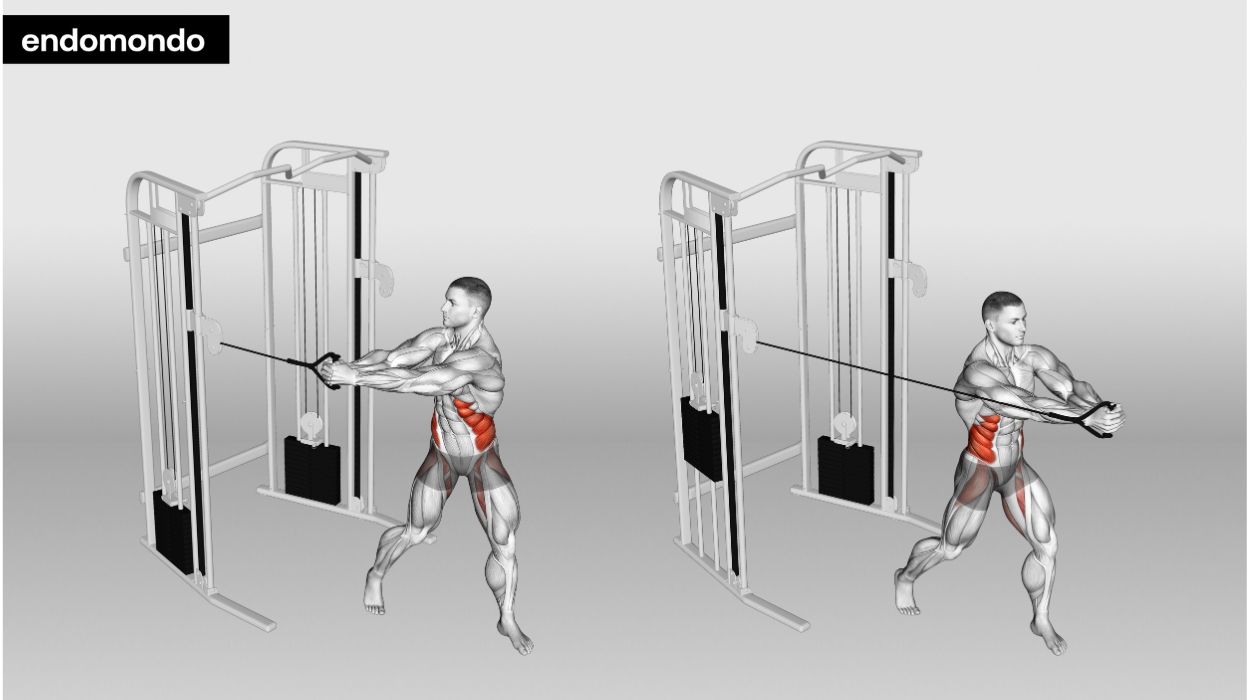
The Cable Russian Twist is a dynamic core exercise targeting the obliques. Performed with a cable machine, the exerciser sits on the ground, slightly leaning back, with knees bent and feet flat. Holding the cable handle with both hands, the movement involves rotating the torso from side to side, pulling the cable across the body, effectively engaging the abdominal and oblique muscles.
How to do:
- Sit on the ground with your knees bent, and pull the cable handle from a low pulley.
- With your back straight, lean back slightly until you can feel your abs engage.
- Keep your hips stationary; twist your torso to one side and then to the other.
- Ensure to keep your movements slow and controlled for maximum benefit.
Tips:
- Maintain a stable lower body: Keep your feet firmly planted and hips stationary to isolate the movement in your core.
- Control the motion: Rotate your torso smoothly and deliberately, focusing on engaging your obliques rather than using momentum.
- Keep your spine neutral: Avoid arching or rounding your back, maintaining a straight spine to prevent strain and maximize effectiveness.
Optimal Sets and Reps: Aim to perform 3-4 sets of 12-15 repetitions on each side.
Cable Pallof Press
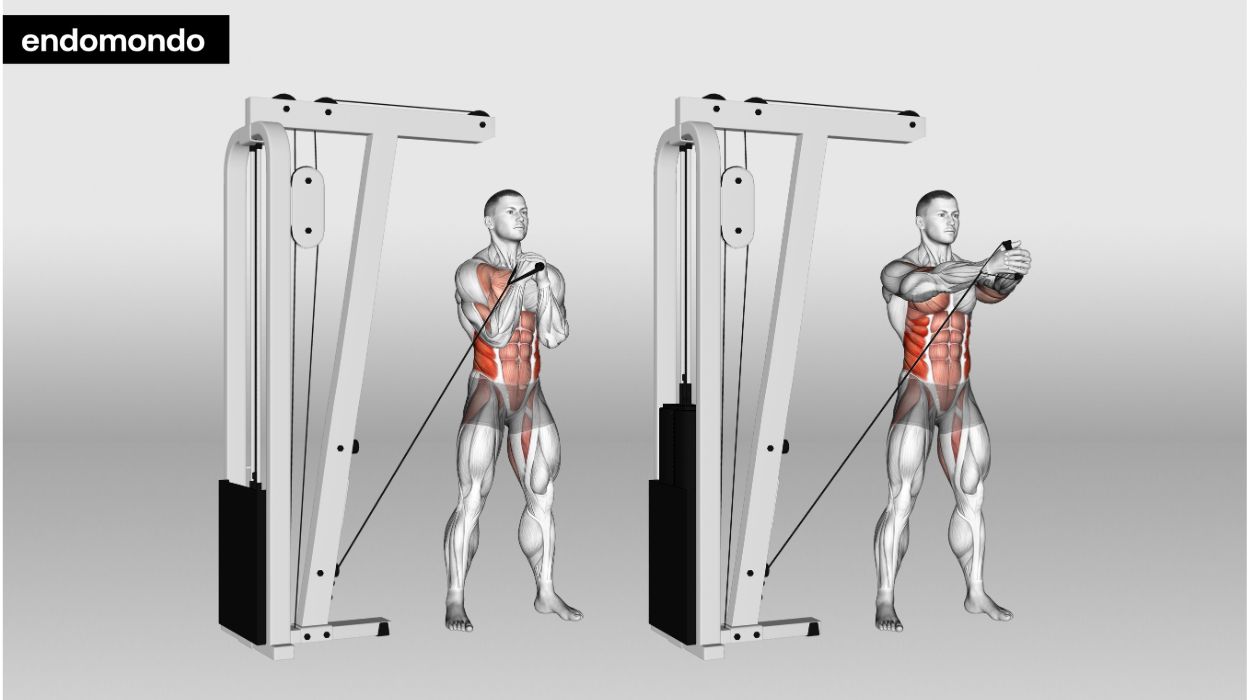
The Cable Pallof Press is a unique core exercise focusing on anti-rotational strength. Performed by standing perpendicular to a cable machine, the individual holds the cable attachment at chest level. The movement involves pressing the cable straight out from the chest and then bringing it back, challenging the core’s stability and resisting rotational forces, effectively strengthening the abdominal and oblique muscles.
How to do:
- Stand sideways to the cable machine, feet shoulder-width apart, and grab the handle with both hands.
- Keep the handle at your chest level.
- Brace your core and press the handle straight out in front of you. Your body will want to turn towards the cable machine but resist it from doing so.
- Hold for a moment, then return the handle to your chest.
- Repeat for the desired number of reps, then switch sides.
Tips:
- Keep your feet shoulder-width apart for a stable base.
- Engage your core throughout to resist rotation and maintain posture.
- Move your arms only, keeping the rest of your body still.
Optimal Sets and Reps: Perform 3 sets of 10-15 reps per side.
Cable Hip Rotation
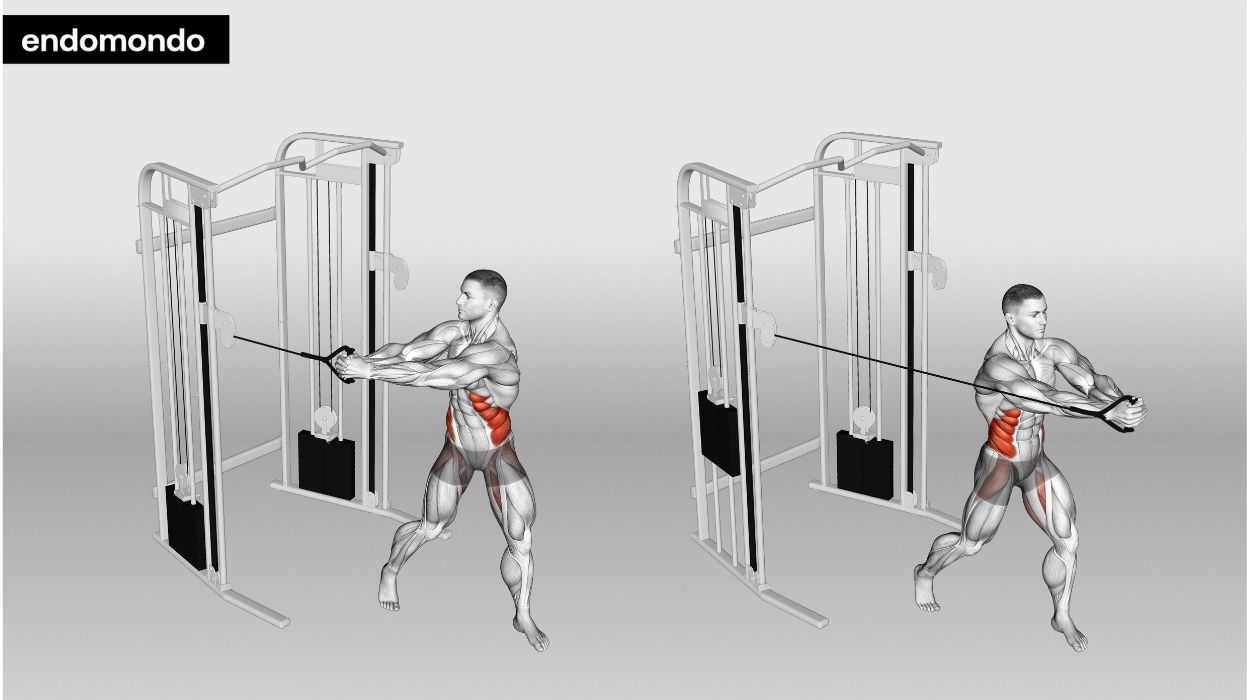
The Cable Hip Rotation exercise focuses on core and hip strengthening. Positioned sideways next to a cable machine with the cable aligned at hip level, the participant holds the handle with both hands. This dynamic movement not only bolsters core stability and hip flexibility but also improves rotational power.
How to do:
- Begin by attaching a cable handle to a low pulley machine. Stand perpendicular to the cable machine with your feet shoulder-width apart. Your side should be facing the machine, and your torso should be upright.
- Grab the cable handle with both hands, holding it close to your chest. Your arms should be extended straight out in front of you.
- Keeping your feet planted, engage your core and initiate the movement by rotating your upper body away from the machine. Your hands and the cable handle should move away from the machine as you rotate.
- Continue rotating until your torso is facing away from the machine. Your hips should remain stable, and the movement should come from your core.
- Slowly reverse the rotation, bringing the cable handle back to the starting position close to your chest.
Tips:
- Maintain a stable stance: Keep your feet firmly planted and knees slightly bent to ensure balance and support during the rotation.
- Focus on controlled movements: Rotate your torso smoothly, using your core muscles, and avoid jerky or rapid motions.
- Keep your arms extended: Hold your arms straight while rotating, allowing your core and hips to drive the movement, not your arms.
Optimal Sets and Reps: It’s optimal to perform 3-4 sets of 10-15 repetitions on each side.
Cable Side Bend
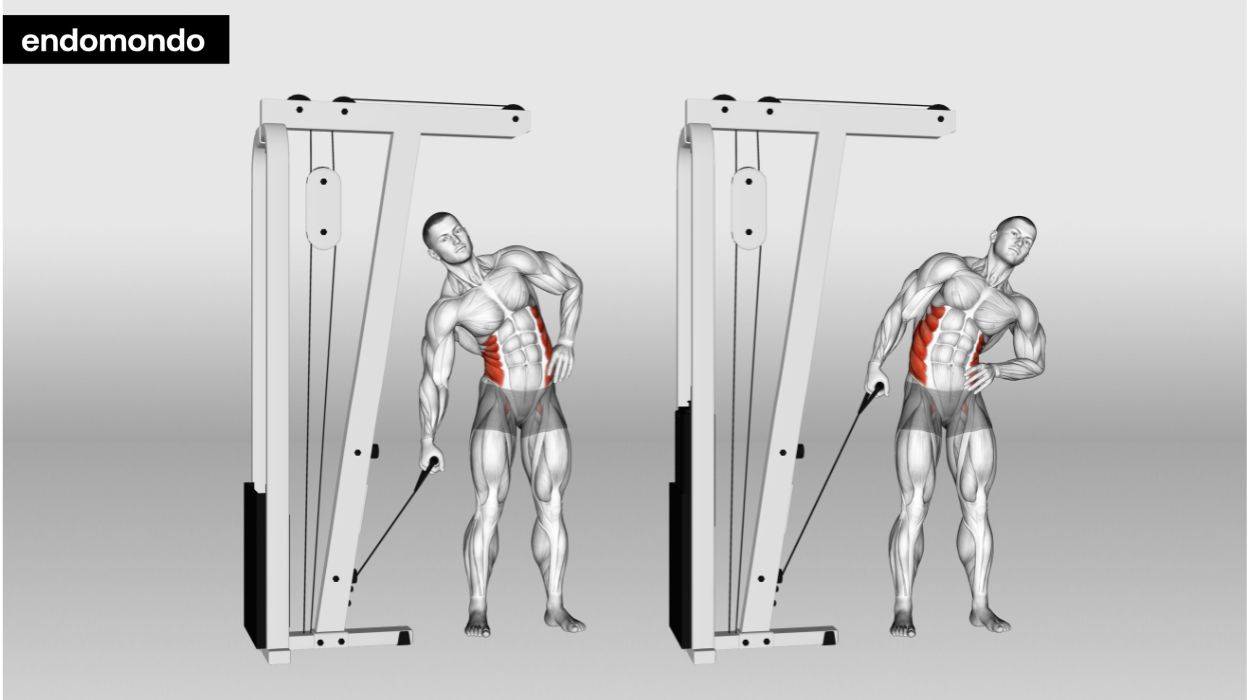
The Cable Side Bend is a targeted exercise for strengthening the oblique muscles. Performed standing beside a cable machine, with one hand holding the cable attachment overhead, the movement involves bending the torso sideways towards the cable, engaging the obliques, and then returning to an upright position. This exercise enhances core stability and defines the side abdominal muscles.
How to do:
- Stand up straight next to a cable machine, holding onto the handle of a low pulley with one hand.
- Keep your feet shoulder-width apart, your gaze forward, and your core tight.
- Bend at your waist to the side, holding the cable, moving your hand towards the same side knee.
- Pause and feel the contraction in your obliques, then return to the starting position in a controlled manner.
- Complete the desired number of reps, then switch sides.
Tips:
- Keep your movements controlled: Bend only at the waist and avoid any forward or backward movement to isolate the obliques effectively.
- Avoid using too much weight: Choose a weight that allows for a full range of motion without straining, ensuring proper form and muscle engagement.
- Maintain a steady pace: Perform each bend smoothly and with control, focusing on the contraction of the obliques and returning to the start position with equal control.
Optimal Sets and Reps: Perform 3-4r sets of 10-12 repetitions on each side.
Common Mistakes
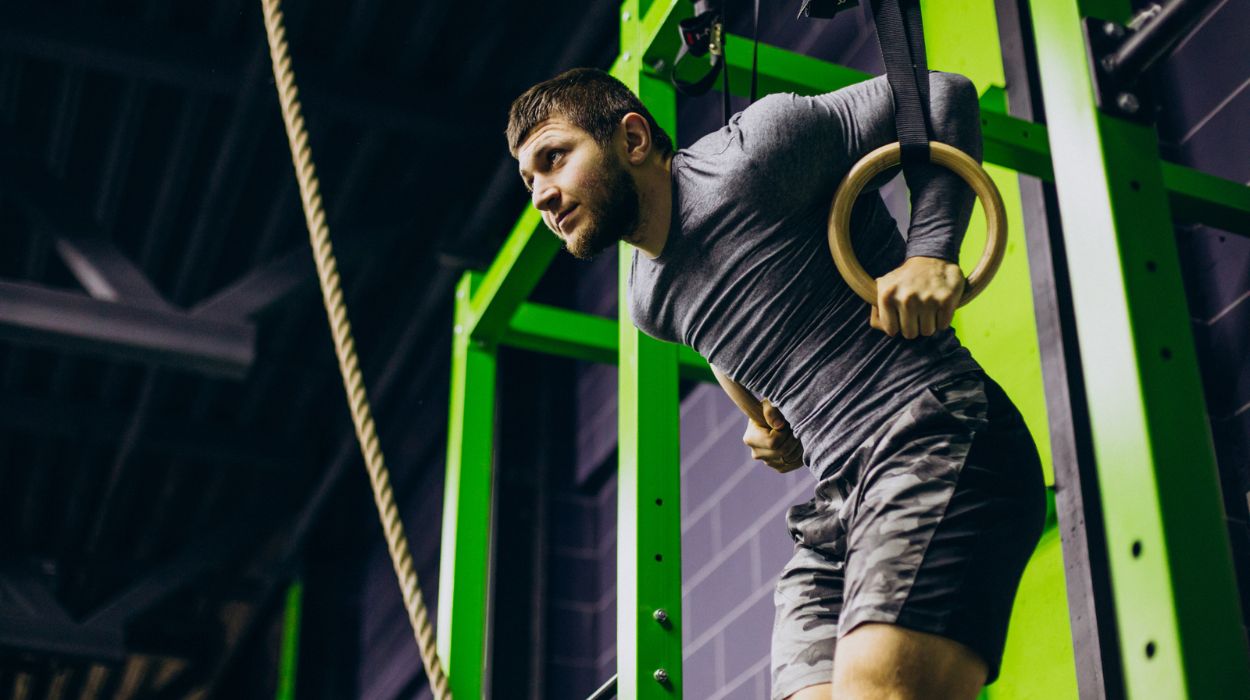
While these cable ab crunch and exercises have many benefits, they are not without their dangers if performed incorrectly. Here are common mistakes I see people make in each, and how you can ensure you avoid them.
Standing Cable Crunch
Mistake: Using too much weight and bending from the hips rather than the waist.
Correction: Select a manageable weight and ensure you bend from your waist, not your hips, for maximum abdominal engagement.
Cable Woodchop
Mistake: Twisting the spine or bending the elbows during the movement.
Correction: Keep your arms straight and twist from the hips to engage the obliques without risking injury to your spine.
Cable Reverse Crunch
Mistake: Using momentum to pull the knees towards the chest.
Correction: Use controlled, slow movements to ensure that your abs are doing the work, not momentum.
Kneeling Cable Crunch
Mistake: Pulling with your arms rather than your abs.
Correction: Keep your arms stationary and use your abs to pull your body downwards in the weighted cable crunches.
Cable Russian Twist
Mistake: Only moving the arms back and forth rather than the torso.
Correction: Rotate the torso from the waist to ensure you’re engaging the obliques and abs fully in this cable seated ab twist.
Cable Pallof Press
Mistake: Allowing your body to rotate towards the machine.
Correction: Resist the cable pull, ensuring your torso remains square to the front.
Cable Hip Rotation
Mistake: Moving the entire body or bending the arms during the movement.
Correction: Keep your arms straight and rotate from your hips, keeping your torso and legs stationary.
Cable Side Bend
Mistake: Bending forward or backward rather than directly to the side.
Correction: Keep your torso upright and ensure you’re bending directly sideways at the waist.
Leave your ego at the door and start with a lighter weight. Establish the correct form, then gradually increase the weight as you strengthen.
Safety Precautions
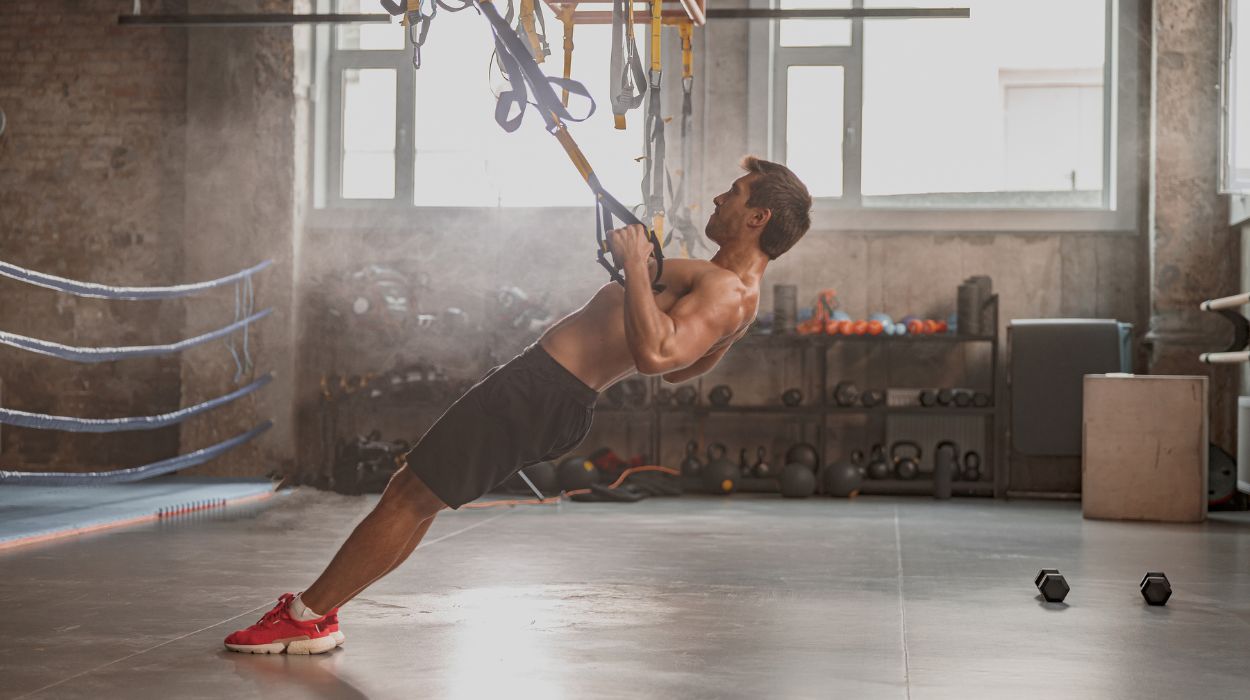
As well as avoiding those common cable core exercise mistakes, here are some essential safety precautions to keep in mind when performing cable ab workouts:
Proper Warm-Up and Cool-Down: Always start with a warm-up to prepare your muscles and joints for exercise and reduce the risk of injury. A proper cool down should be done for the muscles worked to help return your heart and body to a normal resting state.
Correct Form: Ensure you’re executing each move with the proper form. This not only helps target the right muscles but also prevents potential injuries. Consider getting a fitness professional’s help when you’re starting.
Appropriate Weight: Start with a manageable weight. It’s important to maintain control throughout the exercise. Using too much weight can compromise your form and potentially lead to injuries.
Controlled Movements: Avoid using momentum to perform the exercises. All movements should be slow and controlled to ensure maximum muscle engagement and prevent injuries.
Steady Breathing: Don’t hold your breath during these exercises. Instead, maintain steady, rhythmic breathing to avoid cramping.
Always listen to your body, and don’t push yourself beyond your comfort zone. It’s better to make slow, steady progress than to rush and risk an injury.
Conclusion
Remember, while these best cable ab exercises are designed to strengthen and define your abs, they’re just one piece of the puzzle. A balanced fitness routine and proper nutrition are essential in achieving your fitness goals. This fact remains whether your goals are muscle-building, weight loss, or otherwise.
Think of cable workouts as a powerful tool in your fitness toolbox, alongside cardio, strength training, and a healthy diet. Alongside your gym work, you must ensure your body gets the correct nutrition via vitamins and minerals. Supplements can help you plug the gap here if need be.
Embrace the journey, and remember that every workout and rep brings you one step closer to your health and fitness goals. Stay motivated, keep pushing, and let the transformative power of fitness work its magic. Enjoy your workouts!
Frequently Asked Questions
Yes, cable ab workouts are excellent for developing core strength and stability due to the constant tension provided by the cable. They can target all the muscles in the abdominal area and can be easily adjusted to match your fitness level.
This can be subjective, as difficulty can depend on an individual’s strength and fitness level. However, many people find the Hanging Leg Raise to be one of the most challenging ab exercises because it requires significant upper-body strength, stability, and control.
This is a common question (along with “How many ab workouts should I do?”) While it’s possible to train abs daily, it’s generally unnecessary. Like any other muscle group, your abs need time to recover and grow stronger. A good rule of thumb is to train abs 2-3 times weekly.
While cable ab workouts strengthen and tone your abs, they cannot specifically reduce belly fat. Fat loss comes from a combination of a calorie-controlled diet[2] and consistent overall body exercise.
Resources
- Shinkle, J., Nesser, T.W., Demchak, T.J. and McMannus, D.M. (2012). Effect of Core Strength on the Measure of Power in the Extremities. Journal of Strength and Conditioning Research, [online] 26(2), pp.373–380. doi:https://doi.org/10.1519/jsc.0b013e31822600e5.
- Suchacki, K.J., Thomas, B., Yoshiko Matsumoto Ikushima, Chen, K.-C., Fyfe, C., Tavares, A., Sulston, R.J., Lovdel, A., Woodward, H.J., Han, X., Domenico Mattiucci, Brain, E.J., Alcaide-Corral, C.J., Kobayashi, H., Gray, G.A., Whitfield, P.D., Stimson, R.H., Morton, N., Johnstone, A.M. and Cawthorn, W.P. (2023). The effects of caloric restriction on adipose tissue and metabolic health are sex- and age-dependent. eLife, [online] 12. doi:https://doi.org/10.7554/elife.88080.




